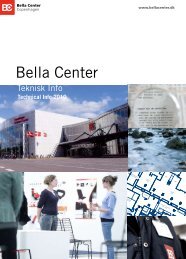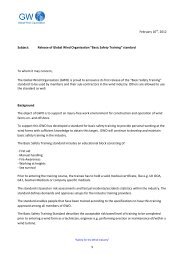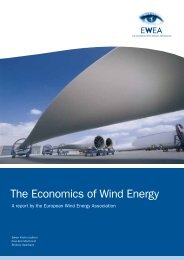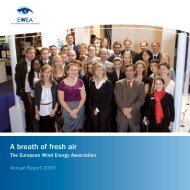Offshore Electricity Infrastructure in Europe - European Wind Energy ...
Offshore Electricity Infrastructure in Europe - European Wind Energy ...
Offshore Electricity Infrastructure in Europe - European Wind Energy ...
You also want an ePaper? Increase the reach of your titles
YUMPU automatically turns print PDFs into web optimized ePapers that Google loves.
• Split Design scenario: An overall grid design built on<br />
the hub case scenario as described <strong>in</strong> chapter 4.5.3.<br />
Cable circuit length and number of <strong>in</strong>stalled<br />
DC converters<br />
The <strong>in</strong>stalled AC and DC cable circuit length for each<br />
scenario is displayed <strong>in</strong> Figure 4.36. The “worst<br />
case” Radial reference scenario, <strong>in</strong> which all offshore<br />
w<strong>in</strong>d farms are connected <strong>in</strong>dividually, exhibits with<br />
42,000 km the largest overall circuit length to be <strong>in</strong>stalled.<br />
The circuit length is dramatically reduced to<br />
28,000 km for the Hub Base Case scenario 2030 <strong>in</strong><br />
which the offshore w<strong>in</strong>d farms are connected to hubs.<br />
The Hub Base Case scenario served as the start<strong>in</strong>g<br />
po<strong>in</strong>t for the overall grid design development. The additional<br />
circuit length to develop these was 3,000 km for<br />
the Split Design and 3,800 km for the Direct Design.<br />
The overall circuit length for the overall grid design is<br />
31,000 km for the Split Design and 32,000 km for the<br />
Direct Design, 10,000 km of which are AC cables <strong>in</strong><br />
each of the cases. Note that these figures show the<br />
circuit length. As AC circuits use 1 x 3 core AC cable<br />
and DC circuits use 2 x 1 core DC cables, the total<br />
cable length is higher.<br />
TAblE 4.7: UTIlISATION OF WINd FARM cAblES<br />
connection<br />
Hub Base Case (Step<br />
0)<br />
Direct Design (Step<br />
2, before mesh)<br />
Direct Design (Step<br />
3)<br />
Split Design (Step 2,<br />
before mesh)<br />
Split Design (Step 3)<br />
40 For Germany onshore connection po<strong>in</strong>ts have been chosen far <strong>in</strong>land. This approach is based on the detailed national study dena-<br />
Netzstudie I (dena grid study I). The connection po<strong>in</strong>ts far <strong>in</strong>land <strong>in</strong>crease the overall connection costs to certa<strong>in</strong> extend.<br />
<strong>Offshore</strong>Grid – F<strong>in</strong>al Report<br />
Dogc-GB<br />
DogE-GB<br />
NorfB-GB<br />
The DC converter numbers for each scenario exhibit<br />
the same characteristics for the different scenarios.<br />
In the Radial reference scenario almost 300 DC <strong>in</strong>verters<br />
are <strong>in</strong>stalled, but the the number is largely reduced<br />
to 206 for the Hub Base Case.<br />
In the f<strong>in</strong>al Direct Design the overall <strong>in</strong>stalled converter<br />
number is 235. In the Split Design 226 converters<br />
are used.<br />
Overall costs of the different scenarios<br />
F<strong>in</strong>ally, Figure 4.38 summarises the overall costs and<br />
lists the overall electricity generation costs. It is important<br />
to highlight that the costs should always be<br />
compared tak<strong>in</strong>g <strong>in</strong>to account the system benefits of<br />
reduced electricity generation costs due to larger trade<br />
capacities via the additional <strong>in</strong>frastructure. Please<br />
note that the <strong>in</strong>frastructure costs have only been assessed<br />
up to the onshore connection po<strong>in</strong>t. 40 Costs<br />
for onshore grid re<strong>in</strong>forcement needs are not <strong>in</strong>cluded.<br />
• Costs and benefits of the Radial reference scenario<br />
It is clearly most expensive to connect all offshore<br />
w<strong>in</strong>d farms <strong>in</strong>dividually without consider<strong>in</strong>g hubs<br />
connections. Includ<strong>in</strong>g the ENTSO-E TYDNP <strong>in</strong>terconnectors,<br />
the <strong>in</strong>vestment costs until 2030 would<br />
amount to €92 bn.<br />
Ljm_5-NL<br />
Cap MW 1,800 1,800 1,800 1,800 1,350 990 900 1,710<br />
Util % 53.8 53.6 53.0 53.4 53.3 56.5 57.1 55.0<br />
Cap MW 1,800 1,800 1,800 1,800 1,350 990 900 1,710<br />
Util % 53.8 71.3 68.4 67.7 68.4 59.0 57.1 65.2<br />
Cap MW 1,800 1,800 1,800 2,800 1,350 990 900 1,710<br />
Util % 53.8 81.8 59.7 77.1 53.3 74.8 57.1 62.8<br />
Cap MW 1,800 1,800 1,800 1,800 1,350 500 500 1,710<br />
Util % 53.8 53.6 59.3 53.4 53.3 85.1 85.2 55.0<br />
Cap MW 1,800 1,800 1,800 2,800 1,350 2,010 500 1,710<br />
Util % 78.3 79.1 55.8 73.0 53.3 79.7 81.5 62.8<br />
Ljm_2-NL<br />
idunn-NO<br />
Ægir-NO<br />
Gaia-DE<br />
75









